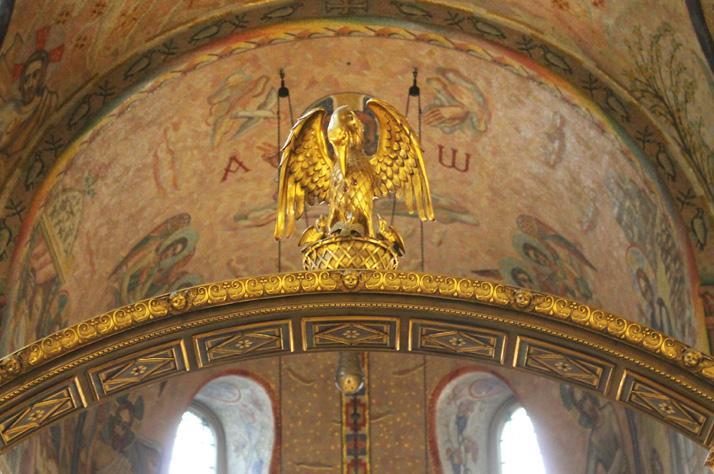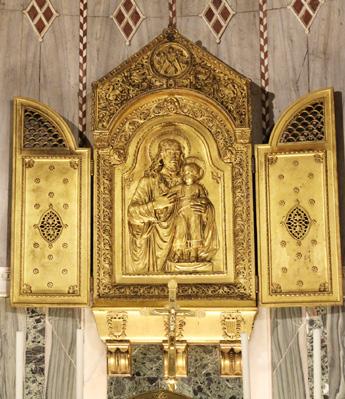
5 minute read
Cathedral History: In Praise of Mr Marshall by Patrick Rogers 16
from Oremus January 2022
his plan for a pulpit. Realising that the original marble pulpit, designed and made in Rome, was both unsuitable and increasingly insecure, his ‘temporary’ wooden pulpit, erected in 1924, in the position occupied by the present one, was used for 20 years. Another example of Marshall’s work is the painted decoration of the Cathedral Hall – now restored to his original design.
Both in the Shrine of the Sacred Heart and nearby in the Vaughan Chantry, all the work, including the simple but effective red, green and gold mosaics in the barrel-roofed shrine, and Cardinal Vaughan’s effigy and sarcophagus carved in white Pentelic marble for the chantry, are also to Marshall’s designs. Similarly, although Bentley had prepared preliminary, partly coloured, designs for the marblework in St Paul’s and St Joseph’s Chapels, the detailed work fell to Marshall, During the 1914-18 War traditional Greek and Turkish marbles – Verde Antico, grey Hymettian, white Pentelic and streaked Proconnesian from the Island of Marmara – went up in St Paul’s, the work in St Joseph’s (the apse) being carried out in 1914, though Marshall’s design for a baldacchino over the altar has never been carried out.
Another reason for remembering Marshall is for his choice of others – the Nonconformist artist Robert Anning Bell RA, who designed both the lovely blue altarpiece in the Lady Chapel (1912) and the great tympanum mosaic over the main entrance doors (1916). And Eric Gill, the controversial sculptor, who carved the Stations of the Cross from 1914-18. In both cases Marshall, a Nonconformist himself, faced opposition from Cardinal Bourne who distrusted non-Catholics and was disappointed with the blue altarpiece and the tympanum mosaic, describing the latter as ‘the greatest disappointment I have received in connection with the work of the Cathedral’. As to the Stations, Gill, a Catholic convert from 1913, writes in his autobiography that Marshall told him he only got the job because he was cheap and Cardinal Bourne was threatening to give the work to the first Catholic he met in the street.
In the mid-1920’s Bourne conceived the idea of forming a permanent school of mosaic workers to decorate the Cathedral and maintain existing mosaics. He had been impressed by the work of the artist Gilbert Pownall, who had painted his portrait in 1923, and arranged for him, together with Marshall as Cathedral architect, to study the mosaics and methods of Venice, Ravenna, Rome and Sicily with a view to the design and production of mosaics for the Cathedral. Pownall clearly enjoyed the trip but it is less certain that Marshall did. He was by then over 70 and not accustomed to travel overseas. He may also have been feeling unwell from cancer of the bowel, which killed him a year or so later; from February 1926 he had been given Lawrence Shattock as an assistant to help him.
Marshall’s work for the Cathedral in the 1920s included the Anning Bell marble and mosaics in the apse (1922), the great marble organ screen above

The Triptych in St Joseph’s Chapel (1914) The Pelican crowning the Arch of the Entrance Screen into the Blessed Sacrament Chapel (1906)
the narthex at the other end of the Cathedral (1924) and the Lady Chapel aisle and transept (1926). Perhaps his last project was designing the two bronze gilt angels, each bearing a trumpet, for the organ screen. They were installed on 23 December 1926. A little over a week later, on 1 January 1927, Marshall was dead. He was 73 and had been complaining of a persistent cough since October. Although he had completed other projects which Bentley had left unfinished – marble and mosaic work in the Church of Our Lady of the Assumption, Warwick Street, additional accommodation for St Thomas’ Seminary, and a wooden altar for St John’s Anglican Church (both in Hammersmith) – the last 30 years of his life had centred on Westminster Cathedral.
A quiet and self-effacing man, Marshall was known to few outside his own family and immediate friends and colleagues. He was content to give all the credit for the Cathedral to Bentley and walk in his shadow. His intimate knowledge of Bentley’s ideas, the structural problems presented by the building and how these were solved, is shown in a paper read by him to the Architectural Association in January 1907. Unfailingly courteous, he refused to respond to often ill-conceived, and sometimes deliberately offensive, criticism of the Cathedral and its decoration. He has no individual memorial here, but just as Bentley’s memorial is the Cathedral itself, so Marshall’s consists of much of the decoration, including the two bronze angels bearing trumpets.
MONTHLY ALBUM Christmas Dinner Contemplated

The Administrator was not actually out shopping for a Christmas turkey when he met this outsize bird. It turned out to be the work of Ron Mueck, an Australian of German parentage, who grew up in the family business of puppetry and doll-making. He worked initially as a creative director in children's television, before moving to America to work in film and advertising. From 1996 he has built up a body of work described as hyperrealistic – and indeed the chicken could well give one nightmares. The end of November and of the liturgical year saw the departure of Will Gaunt, one of the Cathedral Lay Clerks (centre, sixth from left), who has served here for 17 years. A suitable gathering took place in Clergy House Library after Solemn Vespers to mark the occasion and wish him well as he makes the short sea crossing.

Off to Ireland

The Great Sale
In celebration of the possibility of holding a Book Sale again, Advent Sunday saw the SVP and the Friends of the Cathedral join together to attract a crowd with a variety of tempting offers. The optimism of both groups was justified by the results - the SVP made a record profit of £658.50, whilst the Friends came in at marginally under £1,000. In addition, the Daughters of Charity were celebrating the feast day of St Catherine Labouré and Miraculous Medals with Prayer Cards were available for all.









